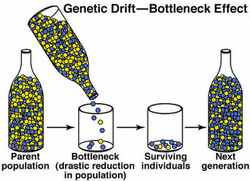
Ecology
An Introduction To Ecology
This blog is going to be used as an educational resource covering the topic of ecology, and we will be case studying animal populations within ecosystems.
Mechanisms Of Evolution

The theory of Evolution is defined as the ways in which an organism changes over time within the environment in which it lives. These mechanisms of evolution, also known as a type of adaptation include mutation, migration, genetic drift, natural selection and non-random mating. Mutations are changes or adaptations that the animal go through to cope with the environment that they live. Mutations occur randomly with individual organisms, according to Sniegowski et al (1995), "mutation is random with respect to its adaptive consequences for individual organisms", which result in (if succesful) more genetic diversity within the population. If the mutation is unsuccesful however these mutations can cause changes that would make the individual organism more susceptible within the environment such as being easier to spot due to changes duch as lack of camoflage so would more at risk from being predated on. Migration adaptations result from geographic variations when there is movement in and out of the gene pool occuring for reasons such as migration for food. Genetic drift happens "to all populations", Undersatanding Evolution (2015), and as a result may or may not improve the gene pool. Some organisms may have more descendents resulting in the passing on of certain genes to these individuals. Natural selection or'survival of the fittest' described by philosopher Herbert Spencer. Non random mating occurs when an organism specifically selects certain charachteristics when selecing a mate. Charachteristics that are more attractive to the organism, such as bright bird colouring will become more pronounced over each generation. These changes or adaptations that happen to the organism are classed as physical (physiological, and anatomical) and behavioural changes and are important for maintaining a healthy gene pool. Figure 1 shows how humans developed from apes.
Figure 1
Gene Pool
Gene pools are the diversity of genes within the same species or a population. Maintaining a healthy gene pool within a population is imporatant for survival. The higher the variety of genes gives a greter chance of reistance to any change within the environment. This also creates a better reproductive ability and greater chance of survival for the species.
Genetic Diversity
Population refers to a certain species,and genetic diversity within a population refers to the different types of genes or genetic material available. The genetic diversity within a population concerns . Genetic diversity refers to or a larger gene pool produce a healthier population which result in mutations and genetic disease reduction whereas a smaller gene pool or smaller population mean that the ability of an organism to adapt to environmental changes are reduced. Loss of "genetic diversity within a species can result in the loss of useful and desirable traits (e.g resistance to parasites)", Biodiversity (2015).

Bottleneck effects
Bottleneck effect is used to describe the effects caused by pressures on the population, an example of pressure could be disease. causing a reduction in the the population. The surviving organisms would aslo be left with a limited gene pool leaving the organisms susceptible.
Adaptations
Adaptations are the ways an organism changes to adapt to its surroundings. Organisms adapt to survive in their environment.
Conservation Genetics
Population genetics is important for the conservation of biodiversity. Biodiversity is the variety of life or the number of different species and population genetics is concerned with genetic variations within populations. Conservation of biodiversity is concerned with preserving natural ecosystems, keeping ecosystems healthy and preventing the extinction of animals.
A populations genetic variation may be conserved through a variety of mechansisms which include;
1. Habitat corridors which can be used to prevent bottlenecking of a population if an area becomes isolated. The habitat corridor can provide a connection between two areas and helps prevent isolation of an ecosystem. (Pictured below in figure 1.2) Habitat corridors take the pressure off resources and space by increasing the size and range of the habitat. Habitat corridors provide access to isolated habitats for species to connect with.
2. Habitat creation can include woodlands, wetlands, hedgerows, grasslands ponds and others. Habitat creations provide a perfect habitat for biodiversity of an ecosystem and according to Gilbert et al, (1998) Habitat creations provide "a dynamic community of interacting plants and animals that should increase in diversity over time".
3. Habitat protection is concerned with protecting a species home (habitat) where the organism shelters, searches for food and breeding oppurtunities. Ensuring the protection of a habitat therfore protects the species survival, and also protects any other species that also live there, Mantra Trust (2015).
4. Species introductions are introduction of individuals into a population or an ecosystem to improve the genetic diversity. Species of animals that can be introduced by humans for conservation efforts to preserve an animal species. Species introduction will affect the balance of an ecosystem in an area and may have positive or negative effects.
5. Breeding programmes with specimen introductions are set up to preserve a species,and hopefully to prevent extinction of an animal. Zoos can set up a breeding programme or a management programme to set up with the hope of being able to release captive bred animals back into the wild populations and habitats. Captive breeding and reintroduction has been succesful for wolves in Yellowstone park and the Large Blue Butterfly that has been reintroduced in South West England. WWF, (29 May 2007).
6. Gene banks create the storage of a plant part,seed, pollen, a few plant cells or leaf that can be used to grow a plant and is referred to as germplasm. These germplasms are collected and stored in a gene bank where they could be used in the future for any plant species that may be destroyed (this conserves the plant) . These stored seeds could be food crops or wild plants that are required to protect biodiversity.
